Mohanthal Recipe
Mohanthal is an Indian sweet made with besan (gram flour), ghee, sugar and flavored with cardamom and saffron. It has a grainy texture and is made for festivals like Diwali!
This post may contain affiliate links. Please read our disclosure policy.
Make the perfect Mohanthal – a sweet fudge made with besan (gram flour), ghee and sugar with this step by step recipe. This recipe is a labor of love but the end result is so worth it. Makes the perfect sweet for festivals like Janmashtami, Navratri and Diwali.
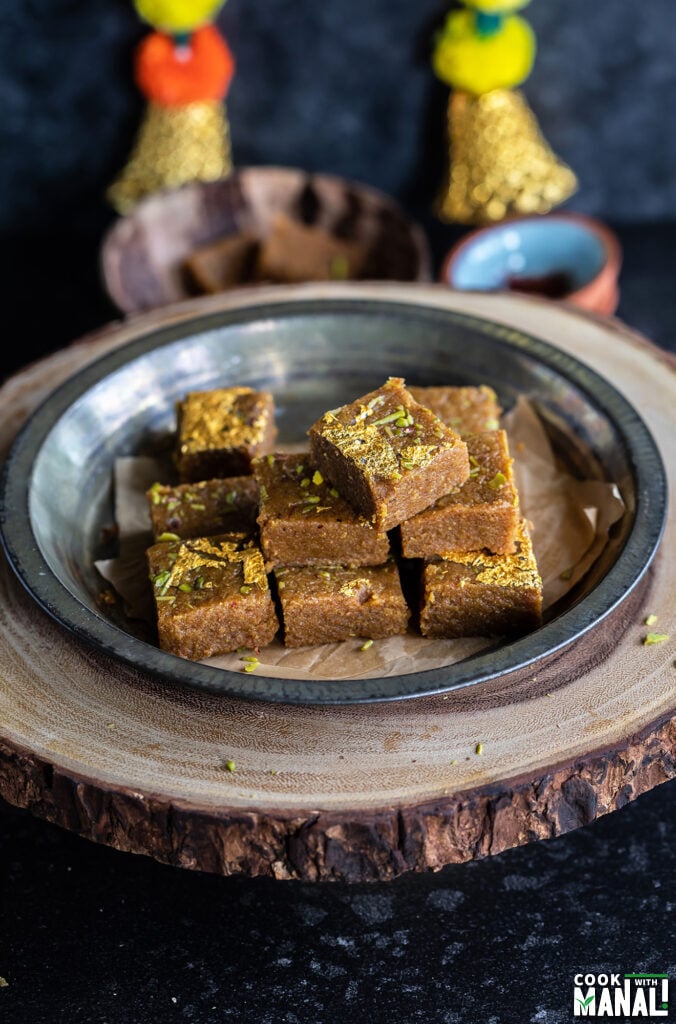
I didn’t grew up eating Mohanthal, in stead I grew up eating besan burfi. I first tasted mohanthal at a friend’s place and was instantly hooked. I have a thing for sweets made with besan (besan ladoo is another favorite of mine) and so mohanthal had my heart from the first bite.
This is my favorite time of the year to make Indian sweets and also the perfect time for me to share this mothanthal recipe with you guys. The combination of besan with ghee and sugar makes this an irresistible sweet. It’s also one of those sweets which I find hard to keep my hands off.
Usually I am okay with taking a few bites of sweets, but anything with besan is a different story. So please don’t ask me how many pieces of mohanthal I ate while testing this recipe!
What is Mohanthal?
Mohanthal is a fudge made with besan, ghee and sugar. It’s often flavored with cardamom, saffron, mace and garnished with nuts. It has a grainy texture. Sometimes, mawa/khoya is also added to it. The sweet is popular in the states of Gujarat and Rajasthan in India.
It’s made in different ways in these 2 states (the cooking technique is different). The sweet is named after Lord Krishna (“mohan” is another name for Lord Krishna) and if often made during the festive season.
Ingredients
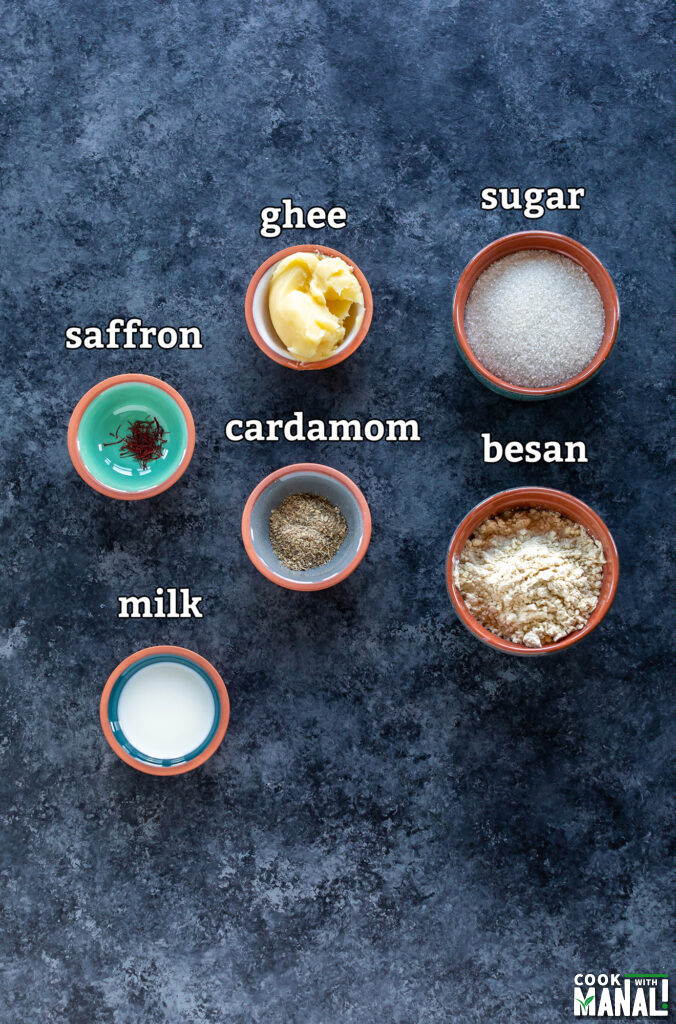
Coarse besan: for that grainy texture, I like using coarse/ladu besan to make mohanthal. You can find it at Indian grocery stores. Regular besan would also do but coarse gives it a better texture.
Ghee: I like using ghee to make mohanthal but you may also use butter. Use unsalted butter in that case.
Sugar: granulated white sugar is what is used to make the sugar sryup for this sweet.
Flavorings: most common flavorings include cardamom, saffron and mace.
Step by Step Instructions
1- In a large bowl, take besan (coarse variety). Then add 1.5 tablespoons melted ghee and 1.5 tablespoons milk to it.
2- Mix with your hands and then rub the mixture between your palms for 2 minutes. This is to ensure that all ghee and milk is incorporated with the besan. This method ensures the grainy texture of the besan which we need for mohanthal.
3- Then take a sifter and sift the mixture. If there’s any leftover which you are unable to sieve, pulse it in your spice grinder until you have a smooth powder and transfer to the same bowl.
4- Once you mixture is all sifted and smooth, cover with a plate and let it sit for 20 minutes.
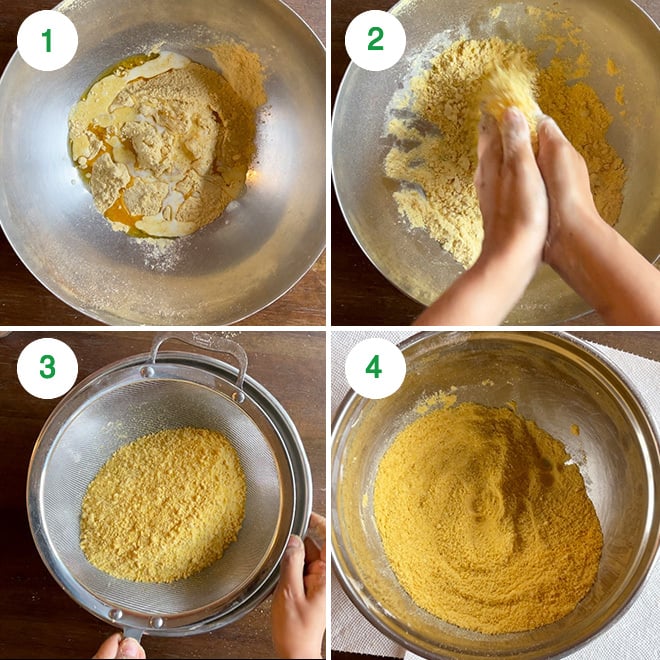
5- After 20 minutes, add melted ghee to a pan on medium heat. Then add the besan to it.
6- Mix using a spatula and start roasting it. Stir continuously and keep roasting on medium heat. After roasting for around 6 to 7 minutes, the besan will become loose and light, like it’s filled with air.
7- Keep roasting until it’s turns light brown/caramel in color. After 10 minutes, besan is roasted and caramel in color. At no point stop stirring.
8- Now reduce heat to low, add 1/4 cup milk to the besan, stir continuously until the milk is absorbed. The texture and color of the besan changes immediately when you add the milk.
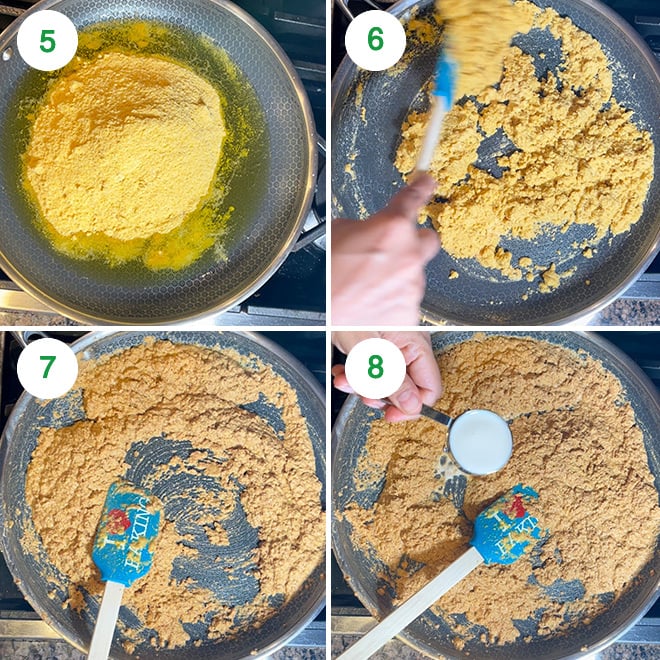
9- Add remaining 1/4 cup milk and again stir until it’s absorbed. At this point, I had roasted the besan in total for 13 minutes on medium heat. Time may differ depending on thickness of pan and intensity of heat.
10- Turn off heat but continue to stir the besan continuously. As the stove in still hot, you continue to stir and cook 5 more minutes. So I cooked the besan for a total of 17 minutes on medium heat. Now, remove pan from stove and set this aside and let it cool down. Besan needs to cool before adding the sugar syrup.
11- Take a pan, add 3/4 cup water and then add 1 cup sugar to it. Once it starts boiling, add 2 tablespoons saffron water (2 tablespoons warm water mixed with generous pinch of saffron strands- let it sit for few minutes until it gets beautiful orange color and then use) and 1 teaspoon cardamom powder. You can also add a pinch of orange food color if you like at this point, I did not add any.
12- After the sugar melts, simmer on low heat for 5 to 6 minutes for the sugar syrup to reach a 1 string consistency (time varies depending on intensity of heat, type of pan etc.). If you place a drop of sugar syrup between your thumb and index finger and pull your fingers apart, it should form a single thread. To get more consistent results, invest in a kitchen thermometer- it should measure 112 C (234 F).
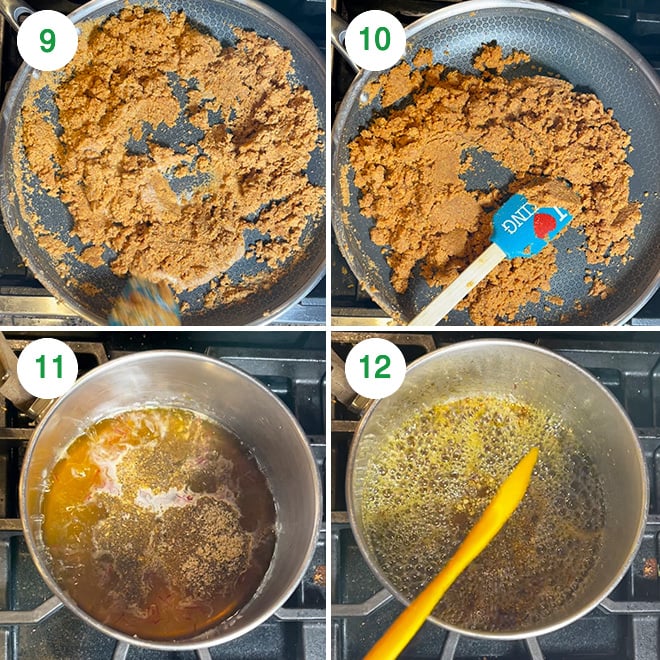
13- Add the sugar syrup to cooled besan (besan should not be hot, it should be at room temperature) and turn heat to low-medium.
14- Mix thoroughly on low-medium heat. Stir for 1 to 2 minutes only until the mixture becomes little thick and also non-sticky. Don’t overcook at this stage else mohanthal will he hard.
15- Transfer to a pan (I used a square 8 x 8 inch pan lined with parchment paper), press with a spatula, garnish with nuts and decorate with edible gold leaves if desired.
16- Let it set for 4 to 5 hours or in the fridge overnight. Once set, cut it into 16 pieces and enjoy!
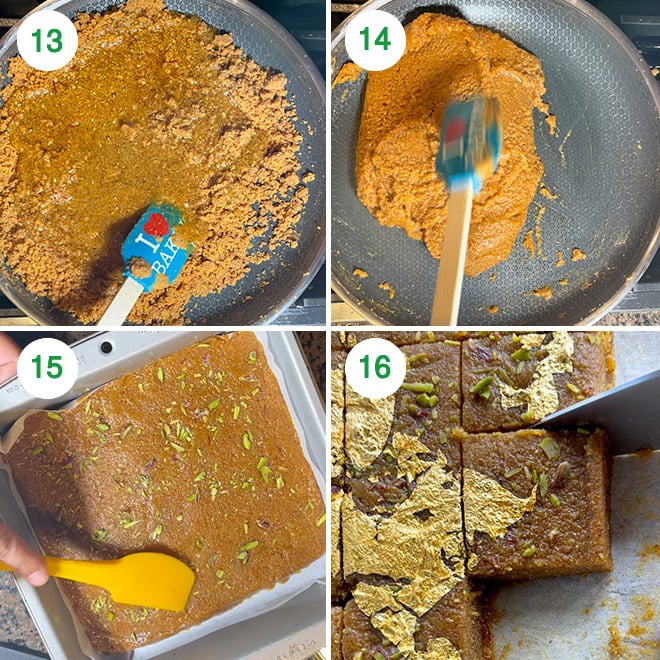
Storage
Store mohanthal in the fridge for up to a month. It will also keep well in an airtight container at room temperature for few weeks. It usually never lasts that long in my house.
Difference with Besan Burfi & Mysore Pak
Looking at the ingredients, all these sweets sound very similar as they use the same basic ingredients- besan, ghee and sugar. But they are different in the technique and the way they are made!
Besan burfi- most popular in northern parts of India, a simple burfi made with roasting besan with ghee and then adding sugar syrup to it. This burfi has a smooth texture.
Mohanthal- has a grainy texture and popular in western parts of India. The step of adding ghee and milk to the besan (called dhrabo in Gujarati) first gives in that unique texture. Mawa is also often added to it.
Mysore pak: a popular sweet in Southern parts of India, for this sweet, a sugar syrup is prepared first and then besan is added to it (reverse of besan burfi and mohanthal). It’s also not garnished with nuts.
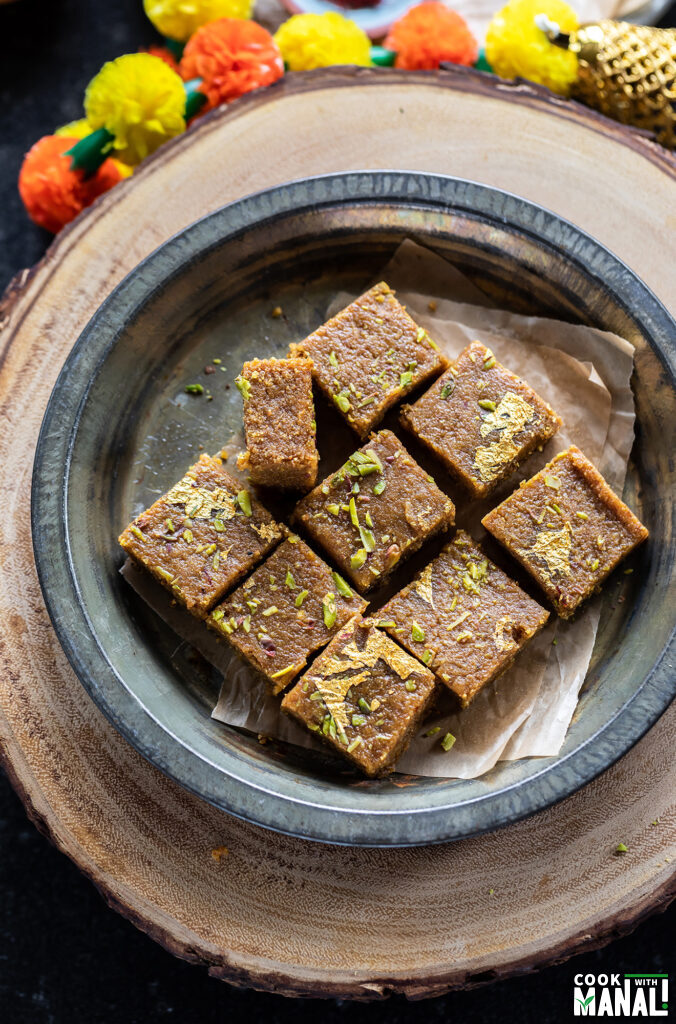
Tips To Keep In Mind
If you have never made mohanthal, here are a few tips that might help!
Use coarse/ladu besan: this is important for that grainy texture of mohanthal. You can make it with regular besan but coarse works better for texture.
Roasting besan right is key: it’s extremely important to roast besan well. If it’s raw the taste of mohanthal will be spoiled and you also don’t want to burn it. So, use a heavy bottom pan, and stir continuously while roasting it. Never leave it unattended.
Sift the besan: to get a mixture without lump, it’s important to sift the besan. Use a sifter to sift the besan after it’s mixed with milk and ghee. If you have some pieces are which big and can’t go through the sifter, transfer them to a spice grinder, pulse until fine and then add to the main bowl.
Cool the besan before adding sugar syrup: after you have roasted the besan, let it cool down before adding the sugar syrup. If you add sugar syrup to hot besan, it might crumble.
Cook until 1 string consistency: if you make a lot of Indian sweets, then you would have a good idea about one string consistency and how to check when it’s done. If not, it’s a good idea to invest in a kitchen thermometer. That will give you more consistency results and eliminate the guess work.
Hope you guys give this mohanthal recipe a try for the festive season!
If you’ve tried this Recipe then don’t forget to rate the recipe! You can also follow me on Facebook, Instagram to see what’s latest in my kitchen and on YouTube to watch my latest videos.
This post has been updated from the recipe archives, first published in August 2013.
Mohanthal
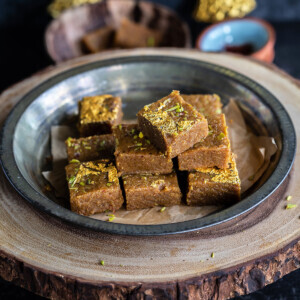
Ingredients
- 1 & 3/4 cup + 1-2 teaspoons besan use coarse/ladu besan, 250 grams
- 1 & 1/2 tablespoon ghee melted, 22 ml
- 1 & 1/2 tablespoon milk I used whole milk, 22 ml
- 1/2 cup + 2 tablespoons ghee melted, 150 ml
- 1/2 cup milk I used whole milk, 120 ml
- 1 cup granulated white sugar 200 grams
- 3/4 cup water 180 ml
- 2 tablespoons saffron water 2 tablespoons (15 ml) warm water mixed with generous pinch of saffron strands- let sit for 5 minutes before using
- 1 teaspoon cardamom powder
Instructions
- In a large bowl, take besan (coarse variety). Then add 1.5 tablespoons melted ghee and 1.5 tablespoons milk to it. Mix with your hands and then rub the mixture between your palms for 2 minutes. This is to ensure that all ghee and milk is incorporated with the besan. This method ensures the grainy texture of the besan which we need for mohanthal.
- Then take a sifter and sift the mixture. If there's any leftover which you are unable to sieve, pulse it in your spice grinder until you have a smooth powder and transfer to the same bowl. Once you mixture is all sifted and smooth, cover with a plate and let it sit for 20 minutes.
- After 20 minutes, add melted ghee to a pan on medium heat. Then add the besan to it. Mix using a spatula and start roasting it. Stir continuously and keep roasting on medium heat. After roasting for around 6 to 7 minutes, the besan will become loose and light, like it's filled with air.
- Keep roasting until it's turns light brown/caramel in color (stir continuously). After 10 minutes, besan is roasted and caramel in color.
- Now reduce heat to low, add 1/4 cup milk to the besan, stir continuously until the milk is absorbed. The texture and color of the besan changes immediately when you add the milk. Add remaining 1/4 cup milk and again stir until it's absorbed. At this point, I had roasted the besan in total for 13 minutes on medium heat. Time may differ depending on thickness of pan and intensity of heat.
- Turn off heat but continue to stir the besan continuously. As the stove in still hot, you continue to stir and cook 5 more minutes. So I cooked the besan for a total of 17 minutes on medium heat. Now, remove pan from stove and set this aside and let it cool down. Besan needs to cool before adding the sugar syrup.
- Take a pan, add 3/4 cup water and then add 1 cup sugar to it. Once it starts boiling, add 2 tablespoons saffron water (2 tablespoons warm water mixed with generous pinch of saffron strands- let it sit for few minutes until it gets beautiful orange color and then use) and 1 teaspoon cardamom powder. You can also add pinch of orange food color if you like at this point, I did not add any.
- After the sugar melts, simmer on low heat for 5 to 6 minutes for the sugar syrup to reach a 1 string consistency (time varies depending on intensity of heat, type of pan etc.). If you place a drop of sugar syrup between your thumb and index finger and pull your fingers apart, it should form a single thread. To get more consistent results, invest in a kitchen thermometer- it should measure 112 C (234 F).
- Add the sugar syrup to cooled besan (besan should not be hot, it should be at room temperature) and turn heat to low-medium. Mix thoroughly on low-medium heat. Stir for 1 to 2 minutes only until the mixture becomes little thick and also non-sticky. Don't overcook at this stage else mohanthal will he hard.
- Transfer to a pan (I used a square 8 x 8 inch pan lined with parchment paper), press with a spatula, garnish with nuts and decorate with edible gold leaves if desired.Let it set for 4 to 5 hours or in the fridge overnight. Once set, cut it into 16 pieces and enjoy!
Notes
- Use coarse/ladu besan: this is important for that grainy texture of mohanthal.
- Roasting besan right is key: it’s extremely important to roast besan well. If it’s raw the taste of mohanthal will be spoiled and you also don’t want to burn it. Stir continuously while roasting it. Never leave it unattended.
- Sift the besan: to get a mixture without lump, it’s important to sift the besan. Use a sifter to sift the besan after it’s mixed with milk and ghee.
- Cool the besan before adding sugar syrup: after you have roasted the besan, let it cool down before adding the sugar syrup. If you add sugar syrup to hot besan, it might crumble.
- Invest in kitchen thermometer: if you make a lot of Indian sweets, then you would have a good idea about one string consistency and how to check when it’s done. If not, it’s a good idea to invest in a kitchen thermometer. That will give you more consistency results and eliminate the guess work.
Nutrition
Nutrition information is automatically calculated, so should only be used as an approximation.

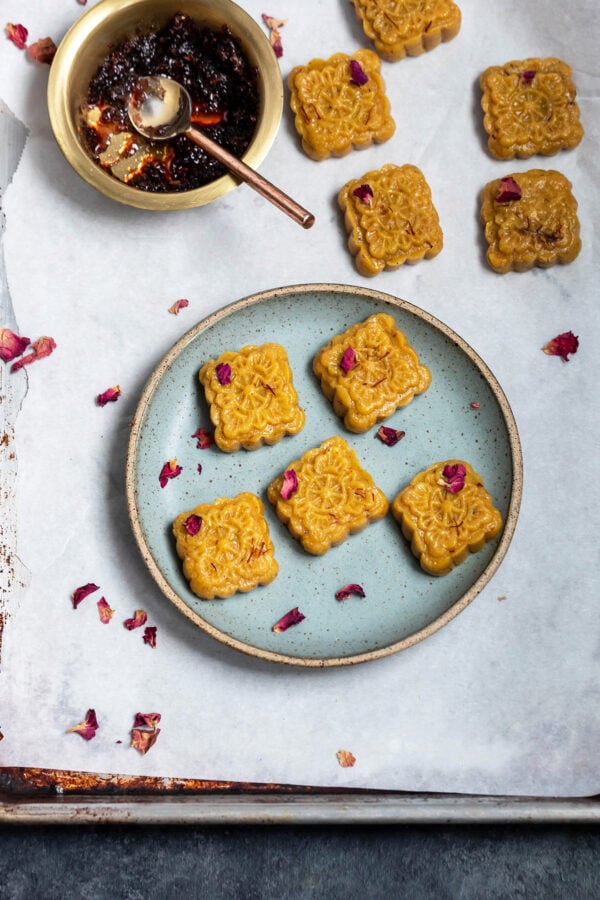
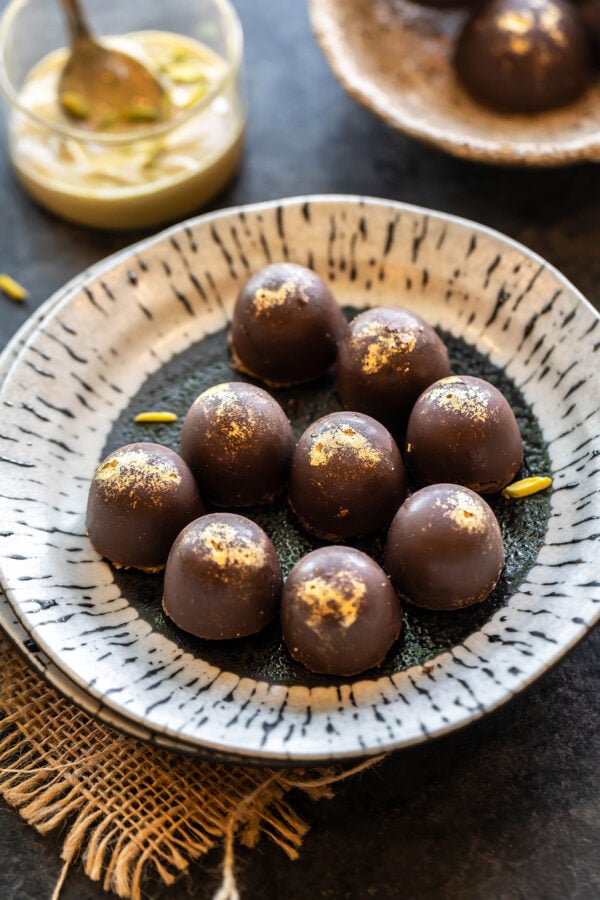
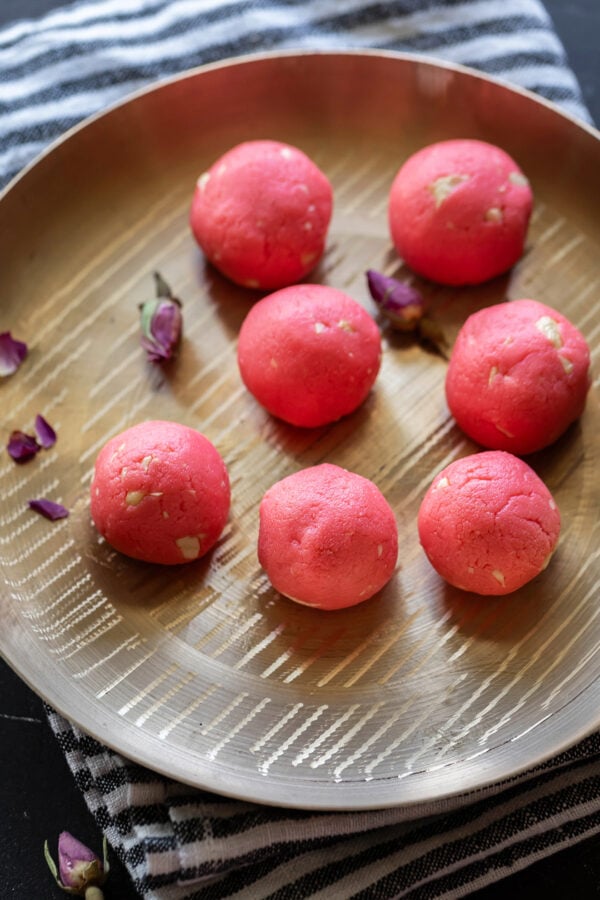
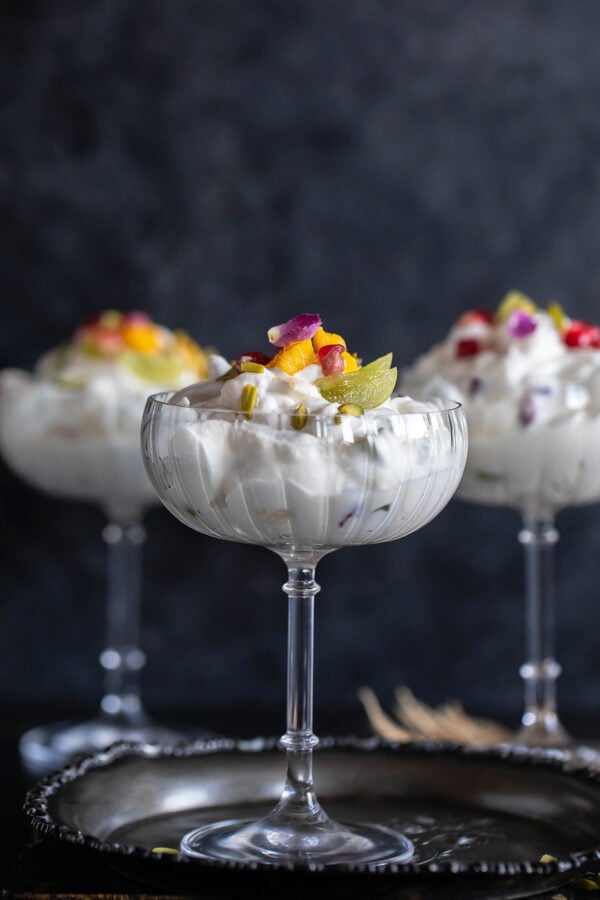









Well explained with proper measurement
thanks
Hi …plz tell me how to fix my soft not set mohanthal burfi
Hi Arti, put the mixture in a pan and back on stove-top. Cook for a few more minutes until it leaves sides of the pan and then set again
hi I am so so happy to have come across your website and have had a lot of success with most of what I made, but for the Mohanthal. It turned out to be dry and the consistency wasn’t like yours. Any tips? What do you think I could have done wrong.
looks like you over cooked the mixture hence it was dry
Hi. Hello from Spain’s Canary Islands. I just bumped into your blog/site and am so glad I did. I am a terribly inexperienced and beginner of a cook (not to say terrible nd lazy cook ha ha). But your recipes look so tempting and inviting to be attempted, specially the simple ones, that I must give it a go. Mouth waters just looking at the sumptuousness in your photographs.
I had a question. Can things like ghee, khoya/mawa be substituted by anything else, as they are not readily available my side? Maybe ghee by oil, or melted butter? Any oil? What about khoya/mawa? Maybe with wholemilk powder? Cottage cheese?
Thanks a lot and Best Wishes for Diwali and beyond.
?
Happy Diwali! yes you can replace ghee with butter, coconut oil also works (except that it will impart coconut taste to whatever you arr making)…for khoya you can add dried milk powder , even almond flour is good to make the sweets richer and add more taste.
Sindhis/Punjabis make Mitha bhat or birange! Can you give method for that? We tried but result was not so good as we tested at one of our Sndhi friend.As such it looks simple but how to get Bhat grains soft and also danedar(Grains separate freely)
Thanks
Ashok Amin USA
Hello Ashok, sure I will try to post the recipe for you!